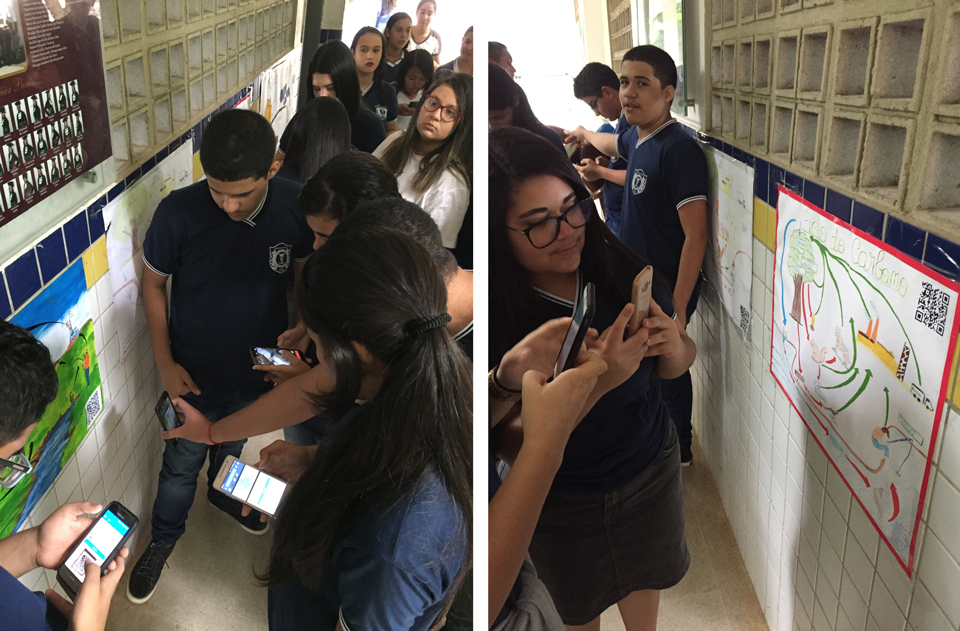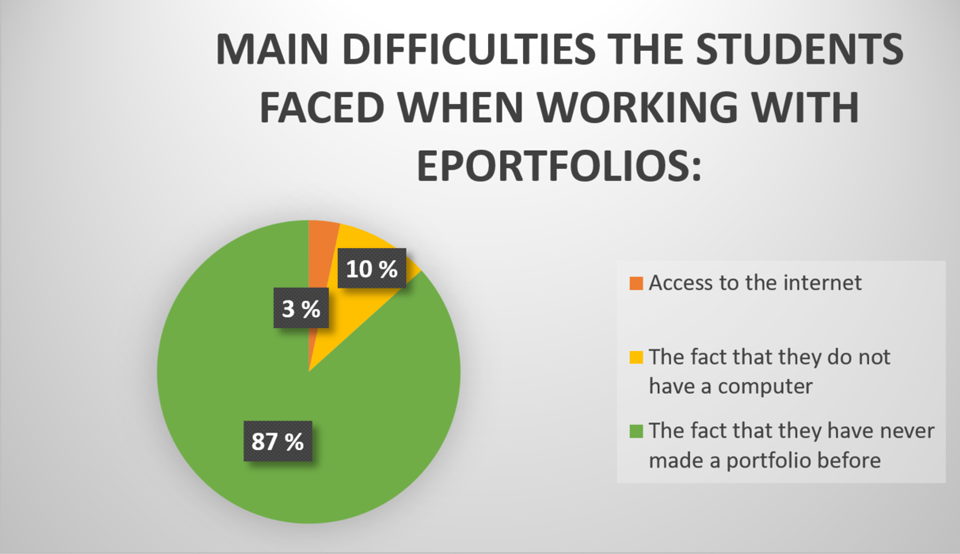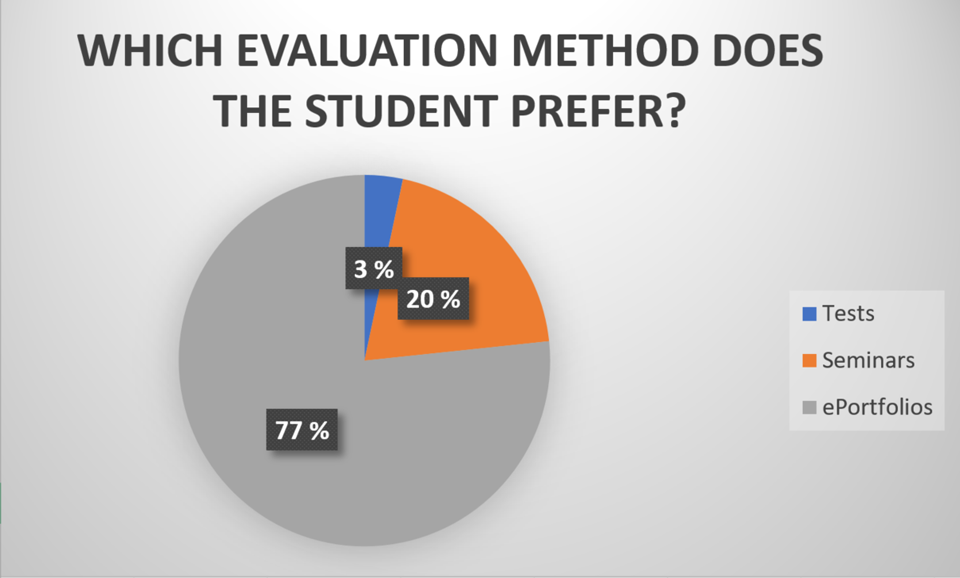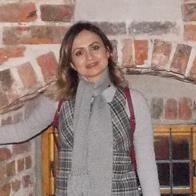
Marja Laurikainen, Alexandre M. Sampaio & Cristiane de Albuquerque Rocha
The purpose of this study is to investigate the introduction of ePortfolios in the chemistry classes of two secondary schools in the state of Paraíba, Brazil. During this process, students’ perceptions of this new teaching and learning method has been researched. In the Brazilian context, the use of ePortfolios is still rather new and often school infrastructures continue to provide additional challenges with a poor internet connection or a low number of IT facilities. Thus, the idea of using ePortfolio as a tool for learning evolved in these kind of challenging circumstances and the outcome, the flipped ePortfolio proved to be a successful solution; combining the use of the ePortfolio and flipped classroom method.The results of this study show that the use of ePortfolio in the classroom made students feel more motivated and proud of their accomplishments and learning. The process with ePortfolios in these two schools continues throughout the academic year and more results will be collected at the end of the year.
Introduction
The rapidly changing world of work, due to phenomena such as globalization and digitalization, transforms and sets new kinds of demands for the studying and working environments. The development of lifelong learning and career management skills, digital competences and 21st century skills (Voogt et al. 2013) becomes an increasingly important task of educators. In order to enhance these skills and competences students need to be more engaged and involved in their own learning and assessment processes.
ePortfolios have been found to promote active learning (Singer-Freeman & Bastone 2016; Yancey 2009; Wang 2009) and ePortfolio pedagogy was recently added as one of the High Impact Practices (HIP) in education highlighting the enhancement of deep learning and student success (Eynon & Gambino 2017; Kuh 2008; Watson, Kuh, Rhodes, Light, & Chen 2016). ePortfolio encourages reflection (Buzzetto-More 2010), academic identity building and future orientation (Hubert 2013), personal growth and a sense of belonging to the community (Eynon, Gambino & Török 2014; Nguyen 2013; Singer-Freeman, Bastone & Skrivaned 2016). Jordine (2015) adds that it brings out a higher level of engagement and work quality in students. However, the benefits of ePortfolio are lost if the learning process is not planned properly with unrelated assignments and a lack of reflective content, or if the students do not get enough support and guidance (Uí Choistealbha 2018). Nonetheless, the use of ePortfolios has grown significantly with more sophisticated online platforms, and the improvement of technologies has led to research in curriculum design and pedagogy that allows owners of ePortfolios to demonstrate and explain their learning in personalized and a student-centered way with constructivist approaches (Kennedy & Shirley 2011; Johnsen 2012).
Barrett (2010) defines ePortfolios as a workspace for learning and reflection and as a showcase being the inventory of all evidence of skills and competences. Smith and Tillema (2003) identify portfolios by purpose (selection vs learning) and volition (voluntary vs mandatory), and they distinguish four different portfolio types: a dossier (mandated, including records of achievement for selection and promotion), a reflective (voluntary, for selection and promotion, usually within the company), a training (mandated, for learning, often in school settings), and a personal development (voluntary, for learning, usually not an official part of curriculum but used to assist learning). The assessment used with ePortfolios is not just assessment of learning or assessment for learning, but also assessment as learning. Thus, ePortfolios utilize self and peer assessing, giving feedback, co-creation of evidence of competences in shared platforms and utilization of different digital applications, which are likely to increase students’ feeling of competence, relatedness and autonomy; fundamental for creating motivation and wellbeing in learning (Kunnari & Lipponen 2010; Ryan & Deci 2000).
In this paper, the authors analyze the data and outcomes from one case study (Yin 2009) and a practitioner action research (Burton & Bartlett 2005) conducted in the project “Teaching Chemistry in the Century XXI” linked to the activities of a pedagogical development programme for teachers in the state of Paraíba, Gira Mundo Finlândia, implemented in long-termcooperation between the state of Paraíba and Häme University of Applied Sciences (HAMK), funded by FAPESQ (Foundation for Research Support of the State of Paraíba).
Gira Mundo Finlândia is a professional development programme for state and public school teachers from Paraíba, Brazil. It is a part of a wider strategic development and internationalization of education in the state of Paraíba and one line of their Giramundo initiative, which also includes e.g. international student exchange. The Gira Mundo Finlândia programme is conducted by Häme University of Applied Sciences (HAMK) and it includes two parts: an intensive 2-month pedagogical programme implemented at HAMK in Finland awarding nine European Credit Transfer System (ECTS) followed by development work in the participants’ own teaching environment in Paraíba (3 ECTS), where they need to develop their own teaching practices, learning environments and learning community.
In this small-scale research, the learning process was examined through a workspace or a training ePortfolio, making students’ learning more visible both to themselves and to additional audiences such as teachers, peers, parents and the whole school community (Eynon, Gambino, & Török 2014). During the chemistry courses, the students were introduced to ePortfolios, and thereafter their experiences and perspectives of the process were collected at the end of the semester in a questionnaire and the results were analyzed. From the results, we can see that the students understood the purpose and benefits of ePortfolio and found themselves more motivated to study with these new methods. Further data will be collected as the project proceeds during the academic year.
Methodology
The data for this article was collected from one case study (Yin 2009) from two state schools in Paraíba, Brazil. The project “Teaching Chemistry in the Century XXI” included a practitioner action research (Burton & Bartlett 2005) where the implementation of ePortfolios in chemistry classes in two state schools was examined.
Case description
The case study and practitioner action research with ePortfolios was developed and conducted in two state schools: ENE Cassiano Ribeiro Coutinho and EEEFM Gentil Lins, which are located in Sapé, in the state of Paraíba, Brazil. In both schools, this is a pioneering activity and the results of the development of the project “Teaching Chemistry in the Century XXI” are linked to the activities of the Gira Mundo Finlândia, a pedagogical development programme for teachers in the state of Paraíba. The aim was to develop a project that extends throughout the school year 2018. At the beginning of that year, the chemistry teacher talked about the proposal to the students, explaining what a portfolio is, and introducing the concept of a digital portfolio with the function of creating, collecting, sharing, reflecting and evaluating the learning and skills developed by the students.
The students were given the freedom to choose their own online open access platform for their ePortfolios -such as a Facebook page, blog, Wix, Youtube or any other way of storing and sharing data. This was done in order to encourage them to present the content and competences the way they wanted to and to increase their creativity as well as the ownership of the whole process.
As a first step, to develop students’ digital competences in educational practices, a Facebook page was created as a channel of communication between the teacher and the students. Further, it has been used to share the success of students in their educational activities, as a way to encourage and motivate them to stay confident in their learning efforts.
A total of 114 ePortfolios in groups of approximately six students were created in the schools and were targeted to develop the skills related to the subject of chemistry as well as the students’ digital skills, English language skills through CLIL methods (Content and Language Integrated Learning) and activities related to creativity and teamwork. Most of the students already had some digital ability; however, it has been an innovative way to use these skills to create a portfolio that necessitates all those general and subject-specific skills, as well. Indeed, it is obvious that basic IT skills and digital competences are essential, and more advanced skills may be needed depending on the platform the students choose to use. In addition, the multimodality in ePortfolios (audio, image, video) makes them more interesting and visual, thus, visual skills are required. Furthermore, general skills such as good writing skills, critical thinking and creativity assist the creation of relevant and interesting content (Kunnari, Laurikainen, & Torseke 2017).
Each group of students was encouraged to create a name that identifies them as a group, and to name their ePortfolio with the same name to highlight their common points and goals – and quite inspiring names have been chosen! After choosing the name, the next step was to create the ePortfolio on a digital platform of their choice. The chosen ePortfolio platforms are listed in Table 1.
| Platform | Number of groups |
|---|---|
| Page on Facebook | 80 |
| Blogger | 19 |
| Wix | 6 |
| Tumblr | 2 |
| Free website by Sora Templates3 | 2 |
| Wordpress | 2 |
| Youtube | 1 |
| Webnode | 1 |
| 1 |
Due to poor or unstable internet connection in these schools, the ePortfolios were created mainly at the students’ homes and the results of the work were presented and discussed at school. Thus, a flipped ePortfolio was adopted that combined the creation and use of ePortfolios and flipped learning; the students were studying the content at home and prepared their assignments and reflections on their ePortfolio, which was then presented in the classroom to the teacher and the peers after which discussion on the topic and the ePortfolios took place to improve understanding.
In addition, the QR code was one of the tools used in the process of sharing the collected information in the portfolios. One of the most important objectives of the project was to empower the students and instigate their pride in their work. Thus, it was important that the results of their good work were seen and complimented by other people in order to receive feedback that would motivate and inspire them and increase their self-confidence.
QR codes were used for the first time by the 2nd grade students with the following strategies: explanation of the tool’s purpose, choice of the application that could generate and read the QR codes (such as “QR code generator”, “Qrafter “, “QR code creator”, “QR code reader”). The students were instructed to produce posters with illustrations about the content (the carbon cycle) studied during the classes and after the classroom exposition, the QR codes were designed for each group’s ePortfolio and added to the posters. The posters were then exposed on the walls of the school corridors for a wider audience where the students from other grades were encouraged to use their cell phones to capture the QR code and explore the work produced by them. It was learning outside the classroom; the corridors of the school were used, in an unusual way for Brazilian context, as a pedagogical space, and a learning environment.

At the end of the first semester of activities, a questionnaire with seven questions was used to sample then evaluate, students’ opinion regarding the work with ePortfolios. The sample was two students per class, a total ofthirty respondents.
The questions were:
- For you, what is an ePortfolio?
- What are the Main Difficulties Faced by the Students with the Work of ePortfolios?
- Access to internet
- The fact that they do not have a computer
- The fact that they had never made a portfolio before
- Have you learned the content (chemistry) through ePortfolio?
- Which Evaluation Method does the student prefer?
- Tests
- Seminars
- ePortfolios
- Would the student like to continue producing ePortfolios in the next school years?
- Assign a grade of 1 (bad) to 10 (excellent) to evaluate the importance of the work (with ePortfolios) for them
- Do you feel more motivated or proud of yourselves when people visualize the work you put into the ePortfolio?
The results presented in the following chapter are only preliminary findings as the process continues and evolves with the mid and long-term results that are yet to come.
Results
The first part of the questionnaire was dealing with students’ understanding and perception of ePortfolios (Q1. For you, what is an e-portfolio?). The responses were consistent with the theoretical definition of ePortfolio presented in the introduction of this article. Each student perceived a nuance of the meaning and purpose of the ePortfolio. According to the students, three types of answers could be identified:
Sharing knowledge and skills within the school and outside the school community:
- a site where we can give information to people
- a system in which we can show what we do at school
- a means of disseminating our learning process.
Inspiring tool for learning and assessment:
- a means of learning, linking technology to studies
- a new way of applying our knowledge
- an innovative means of evaluation
- a tool to make work more efficient.
A tool for interaction with others:
- a Facebook page that interacts with people through chemistry
- a well-interactive method of study.
As to the difficulties faced by the students, the results are presented in Figure 2. This indicates that the methodological difficulties are more meaningful than the structural ones, as 87 percent of the students answered that the main difficulty was that they had never created or used ePortfolios before.

The third question was related to the learning process and how well the content can be learnt with this new method. All the respondents, one hundred percent (100%) of the students said that they learnt the content well with this approach showing that the use of ePortfolios is a pedagogically effective method.
The fourth question was related to evaluation with ePortfolios and with traditional methods (tests and seminars). The results are presented in Figure 3.

We can notice that most of the students prefer the methods of learning and active assessment with ePortfolios. Even though the seminar presentations are also an active method, 77 percent of the students preferred evaluation through ePortfolios, and only three percent of the students prefer the traditional method of having tests.
The fifth question asked whether the student would like to continue producing ePortfolios in the next school year. Again, all of the students (100%) said they would like to continue with their ePortfolios.
In order to evaluate the importance and significance of ePortfolios in the teaching and learning process from the students’ point of view, they were asked to assign a grade of one (bad) to ten (excellent) to evaluate how important the ePortfolio work has been for them. The arithmetic mean of assigned scores was 9.1, which shows that students were aware of the importance and could recognize the benefits of ePortfolios in the teaching-learning process.
One of the goals of the “Teaching Chemistry in the 21st Century” project was to make the students to feel proud of their efforts and motivate them to feel responsible and happy about their work. The final question of the questionnaire was evaluating whether this goal has been achieved: Do you feel more motivated or proud of yourselves when people visualize the work you put into the ePortfolio? As a result, twenty-seven students out of thirty (90% of the sample) answered “yes”, i.e. they feel more motivated to study with their ePortfolios, whereas none of the respondents answered “no”. Three students (10%) answered to be indifferent about this issue.
The CLIL (Content and Language Integrated Learning) was used together with the ePortfolios. During May and June in 2018, there was an integrated collaborative activity between chemistry and English subjects, in which the students from two 3rd grade classes of ENE Cassiano Ribeiro Coutinho School, with the guidance from the teachers, produced a video in English, even with their limited language skills, about hydrocarbons and organochlorine compounds. The video was uploaded into the ePortfolios of these two groups.
In Brazil, students have a lot of difficulty in the verbal language skills as they seldom have the opportunities to use and practice the English language. They feel shy and uncertain to speak in English (or in a foreign language in general). An important result of this project with CLIL was to help them overcome the shyness and feel confident enough to practice a foreign language (in this case English), even with some difficulties in pronunciation. This was just a starting point, but it was very evident how grateful the students were to receive this encouragement, and some of them expressed the desire to deepen their studies in the English language.
Discussion
The use of ePortfolio in higher education has become increasingly prevalent, at least in some countries (Rhodes, Chen, Watson & Garrison 2014). Further, there is an interest in ePortfolios amongst educators in general, driven by the belief that ePortfolios may evoke unique reactions from students (Buyarski & Landis 2014). Still, the purpose or benefits of ePortfolios are still scarcely recognized in basic or secondary education. In addition, some basic infrastructural issues restrict the use of ePortfolios, i.e. the areas or countries where the internet connection is not self-evident; such is the reality in the Brazilian context as well. However, as the case study presented in this paper demonstrates there are ways to overcome these challenges. Furthermore, the new practices were successful in motivating the students to be more engaged in their learning process.
Due to the limitations of computer and internet access in the schools, the learning took place mainly at the students’ home or outside of school. However, based on the results from the small-scale study the students did not see this as the main difficulty but were more challenged by the fact that they did not have previous knowledge about ePortfolios and did not understand how they could learn chemistry in a new way with ePortfolios. This kind of flipped ePortfolio that combines the use of ePortfolios and flipped learning gave positive results; the students were able to discuss and adjust their portfolios in the classroom with their peers and the teacher and present their results of the ePortfolio work to their peers in other grades as well as the whole school community.
Not all of the ePortfolios created were excellent, some out of the 114 were incomplete and could have been better in quality, however, taking into consideration the overall work, the students’ engagement was noteworthy. In addition, the teaching and learning processes could benefit from using ePortfolios by making the students active agents of their own learning and applying other innovative tools and practices. Nonetheless, embedding ePortfolios to the learning process does not have to be rocket science as this quote from one of the students demonstrates: ePortfolio is “A way of learning content in a simple way”.

This article was produced in the Erasmus+ (KA2 action) funded project “Empowering Eportfolio Process (EEP)”. The beneficiary in the project is Häme University of Applied Sciences (FI) and the partners are VIA University College (DK), Katholieke Universiteit KU Leuven (BE), University College Leuven-Limburg (BE), Polytechnic Institute of Setúbal (PT) and Marino Institute of Education (IE). The project was implementated during 1.9.2016–30.11.2018.
Authors

Marja Laurikainen, MBA from University of Wales Trinity Saint David, Education Development Specialist at Global Education in the School of Professional Teacher Education of the Häme University of Applied Sciences, Finland.

Alexandre M. Sampaio, chemistry teacher from state public schools in Paraíba – Brazil, graduated from the Universidade Federal da Paraíba – UFPB, took the course of Gira Mundo Finlândia Paraíba, cohort II at Häme University of Applied Sciences.

Cristiane de Albuquerque Rocha, English teacher from State Technical School of Paraíba – Brazil, graduated from the Universidade Federal da Paraíba – UFPB, took up the course of Gira Mundo Finlândia Paraíba, cohort II at Häme University of Applied Sciences.
References
Barrett, H. (2010). Balancing the Two Faces of ePortfolios. Educação, Formação & Tecnologias, 3(1), 6‒14. Retrieved 2 November 2018 from http://eft.educom.pt/index.php/eft/article/viewFile/161/102
Burton, D. & Bartlett, S. (2005). Practitioner Research for Teachers. London: Paul Chapman Publications.
Buyarski, C. A. & Landis, C. M. (2014). Using an ePortfolio to assess the outcomes of a first-year seminar: Student narrative and authentic assessment. International Journal of ePortfolio, 4(1), 49‒60. Retrieved 1 September 2018 from http://www.theijep.com/pdf/IJEP133.pdf
Buzzetto-More, N. (2010). Assessing the efficacy and effectiveness of an ePortfolio used for summative assessment. Interdisciplinary Journal of E-Learning and Learning Objectives, 6, 61‒85.
Eynon, B. & Gambino, L. M. (2017). High-impact ePortfolio practice: A catalyst for student, faculty and institutional learning. Sterling, VA: Stylus.
Eynon, B., Gambino, L. M., & Török, J. (2014). What difference can ePortfolio make? A field report from the connect to learning project. International Journal of ePortfolio, 4, 95‒114. Retrieved 1 September 2018 from http://www.theijep.com/pdf/ijep127.pdf
Hubert, D. (2013). ePortfolios in student roadmaps at Salt Lake Community College. Peer Review, 15(2), 25‒26.
Johnsen, H. (2012). Making learning visible with ePortfolios: Coupling the right pedagogy with the right technology. International Journal of ePortfolio, 2(2), 139‒148. Retrieved 1 September 2018 from http://www.theijep.com/pdf/IJEP84.pdf
Jordine, M. (2015). A holocaust exhibit ePortfolio: Actively engaging students. International Journal of ePortfolio, 5(1), 15‒24. Retrieved 1 September 2018 from http://www.theijep.com/pdf/IJEP162.pdf
Kennedy, D. & Shirley, C. (2011). Innovative curriculum design: Using ePortfolios to change practice and process. In S. Barton, J. Hedberg & K. Suzuki (Eds.), Proceedings of Global Learn 2011, 409‒416. Retrieved 2 November 2018 from https://www.learntechlib.org/p/37204/
Kuh, G. D. (2008). High-impact educational practices: What they are, who has access to them, and why they matter. Washington, DC: Association of American Colleges and Universities.
Kunnari, I., Laurikainen, M., & Torseke, J. (2017). Triggering students to create ePortfolios. In I. Kunnari & M. Laurikainen (eds.) Students’ perspectives in ePortfolios. HAMK Unlimited Journal 15.12.2017. Retrieved on 19 Sep 2018 from https://unlimited.hamk.fi/ammatillinen-osaaminen-ja-opetus/triggering-students-to-create-eportfolios
Kunnari, I. & Lipponen, L. (2010). Building teacher-student relationship for wellbeing. Lifelong Learning in Europe, 2, 2010.
Nguyen, C. F. (2013). The ePortfolio as a living portal: A medium for student learning, identity, and assessment. International Journal of ePortfolio, 3(2), 135‒148. Retrieved 1 September 2018 from http://www.theijep.com/pdf/IJEP116.pdf
Rhodes, T., Chen, H. L., Watson, C. E. & Garrison, W. (2014). Editorial: A call for more rigorous ePortfolio research. International Journal of ePortfolio, 4(1), 1‒5. Retrieved 1 September 2018 from http://www.theijep.com/pdf/IJEP144.pdf
Ryan, R.M. & Deci, E.L. (2000). Self-determination theory and the facilitation of intrinsic motivation, social development, and well-being. American Psychologist, 55, 68‒78.
Singer-Freeman, K. E. & Bastone, L. (2016). Pedagogical choices make large classes feel small (Occasional Paper No. 27). Urbana, IL: University of Illinois and Indiana University, National Institute for Learning Outcomes Assessment.
Singer-Freeman, K. E., Bastone, L. & Skrivanek, J. (2016). Using ePortfolios to assess applied and collaborative learning and academic identity in a summer research program for community college students. International Journal of ePortfolio, 6(1), 45‒57. Retrieved 1 September 2018 from http://www.theijep.com/pdf/IJEP202.pdf
Smith, K. & Tillema, H. (2003). Clarifying different types of portfolio use. Assessment & Evaluation in Higher Education, 28(6), 625‒648. doi:10.1080/0260293032000130252
Uí Choistealbha, J. (2018). The benefits and challenges of using ePortfolios. In I. Kunnari & M. Laurikainen (eds.) Students’ perspectives in ePortfolios. HAMK Unlimited Journal 31.1.2018. Retrieved on 19 Sep 2018 from https://unlimited.hamk.fi/ammatillinen-osaaminen-ja-opetus/the-benefits-and-challenges-of-using-eportfolios
Wang, S. (2009). Inquiry directed organization of ePortfolio artifacts for reflection. International Journal of E-learning and Learning Objectives, 5, 421‒433.
Watson, C. E., Kuh, G. D., Rhodes, T., Penny Light, T. & Chen, H. L. (2016). Editorial: ePortfolios – The eleventh high impact practice. International Journal of ePortfolio, 6(2), 65‒69. Retrieved 1 September 2018 from http://www.theijep.com/pdf/IJEP254.pdf
Voogt, J., Erstad, O., Dede, C. & Mishra, P. (2013). Challenges to learning and schooling in the digital networked world of the 21st century. Journal of computer assisted learning, 29(5), 403‒413.
Yancey, K. (2009). Electronic portfolios a decade into the twenty-first century: What we know, what we need to know. Peer Review, 11(1), 28‒32.
Yin, R.K. (2009). Case Study Research. Design and Methods. 4th ed. Applied Social Research Methods Series, vol. 5. USA: Sage Publications.





